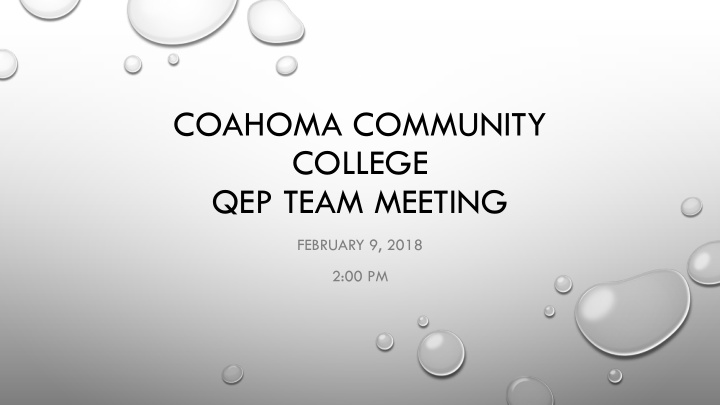



COAHOMA COMMUNITY COLLEGE QEP TEAM MEETING FEBRUARY 9, 2018 2:00 PM
WELCOME • Ms. Glynda Duncan, QEP Chair • Welcome • Ms. Margaret Dixon, Institutional Effectiveness/SACS Liaison Director , Office of Institutional Effectiveness • The task ahead
THE QEP HANDBOOK FOR INSTITUTIONS SEEKING R EAFFIRMATION THE INSTITUTION HAS A QUALITY ENHANCEMENT PLAN THAT (A) HAS A TOPIC IDENTIFIED THROUGH ITS ONGOING, COMPREHENSIVE PLANNING AND EVALUATION PROCESSES; (B) HAS BROAD-BASED SUPPORT OF INSTITUTIONAL CONSTITUENCIES; (C) FOCUSES ON IMPROVING SPECIFIC STUDENT LEARNING OUTCOMES AND/OR STUDENT SUCCESS; (D) COMMITS RESOURCES TO INITIATE, IMPLEMENT AND COMPLETE THE QEP; AND (E) INCLUDES A PLAN TO ASSESS ACHIEVEMENT.
Contents for the Quality Enhancement Plan generally include the following components: • I. Executive Summary (one page) • II. Process Used to Develop the QEP : • Evidence of the involvement of all appropriate campus constituencies (providing support for compliance with CS 3.3.2 “includes a broad-based involvement of institutional constituencies in the development…of the QEP”) • III. Identification of the Topic : • A topic that is creative and vital to the long-term improvement of student learning (providing support for compliance with CR2.12 “focuses on learning outcomes and/or the environment supporting student learning”) • IV. Desired Student Learning Outcomes : • Specific, well-defined goals related to an issue of substance and depth, expected to lead to observable results (providing support for compliance with CS 3.3.2 “identifies goals”) • V. Literature Review and Best Practices : • Evidence of consideration of best practices related to the topic (providing support for compliance with CS 3.3.2 “institutional capability for the initiation, implementation, and completion of the QEP”)
Contents for the Quality Enhancement Plan generally include the following components: (Cont.) • VI. Actions to be Implemented: • Evidence of careful analysis of institutional context in designing actions capable of generating the desired student learning outcomes (providing support for compliance with CS 3.3.2 “institutional capability for the initiation, implementation, and completion of the QEP”) • VI. Timeline : A logical calendaring of all actions to be implemented • (providing support for compliance with CS 3.3.2 “institutional capability for the initiation, implementation, and completion of the QEP”) • VIII. Organizational Structure : • Clear lines of responsibility for implementation and sustainability (providing support for compliance CS 3.3.2 “institutional capability for the initiation, implementation, and completion of the QEP”) • IX. Resources : • A realistic allocation of sufficient human, financial, and physical resources (providing support for compliance CS 3.3.2 “institutional capability for the initiation, implementation, and completion of the QEP”) • X. Assessment : • A comprehensive evaluation plan (providing support for compliance with CS 3.3.2 “a plan to assess their achievement”) • XI. Appendices (optional)
DEVELOPING A TOPIC • Initial survey to evaluate needs of the institution (done) • Evaluate survey findings and develop more focused survey to determine final topic (today) • Draft/approval of new survey (today) • Choosing topic – next meeting March 9th
RESULTS INITIAL SURVEY
RESULTS INITIAL SURVEY
RESULTS INITIAL SURVEY
RESULTS INITIAL SURVEY
WRITTEN COMMENTS
WRITTEN COMMENTS
WRITTEN COMMENTS
WRITTEN COMMENTS
WRITTEN COMMENTS
WRITTEN COMMENTS
WRITTEN COMMENTS
WRITTEN COMMENTS
WRITTEN COMMENTS
WRITTEN COMMENTS
WRITTEN COMMENTS
WRITTEN COMMENTS
WRITTEN COMMENTS
WRITTEN COMMENTS
WRITTEN COMMENTS
SURVEY 1 RESULTS Survey Results Totals % Responded N/A 2 2 7 3 3 7 4 5 2 2 5 7 5 14 15 3 86 24.86% Advising/Communications 4 2 3 4 1 6 5 6 4 6 2 4 4 2 9 7 1 70 20.23% Personal accountability 6 3 5 2 3 3 3 5 2 3 2 1 5 5 3 2 1 54 15.61% Problem employee/faculty 2 5 3 1 2 2 2 2 5 2 26 7.51% Great/no problem 3 2 2 1 8 6 4 26 7.51% Classroom issue 1 1 4 2 4 7 19 5.49% Safety (Profanity/Drugs) 1 2 1 1 2 1 1 1 2 1 1 14 4.05% Tutoring Services 2 2 3 1 1 1 1 11 3.18% Wifi problems 1 1 1 1 1 5 1.45% Dorm/study areas 2 1 1 1 5 1.45% online/canvas 2 2 4 1.16% Fin. Aid 1 1 1 1 4 1.16% Orientation 1 2 3 0.87% Job help 1 1 1 3 0.87% lack of prog/classes-online 1 1 1 3 0.87% Unprepared for college 2 2 0.58% Computer access 1 1 2 0.58% Need campus activities 2 2 0.58% Writing Help 1 1 0.29% Everything 1 1 0.29% Student Union 1 1 0.29% food 1 1 0.29% Library 1 1 0.29% Honor College 1 1 0.29% Band 1 1 0.29% Technology 0 0.00% 346 100.00%
FINAL RESULTS • Out of 346 comments, 20 (~20%) was on advising & communications • A full copy of the survey results is available
NEXT STEP • Look at existing data to further justify Advising and Communication as the topic of choice • Others items that will be used to select a topic. • Strategic Plan Results • Report Cards • Budgets • Program Reviews • Annual Reports • Dixon/Roberson to expand • Assignment: Review the above to back up the Advising/Communication topic • Set next meeting (March 9 th )
Recommend
More recommend